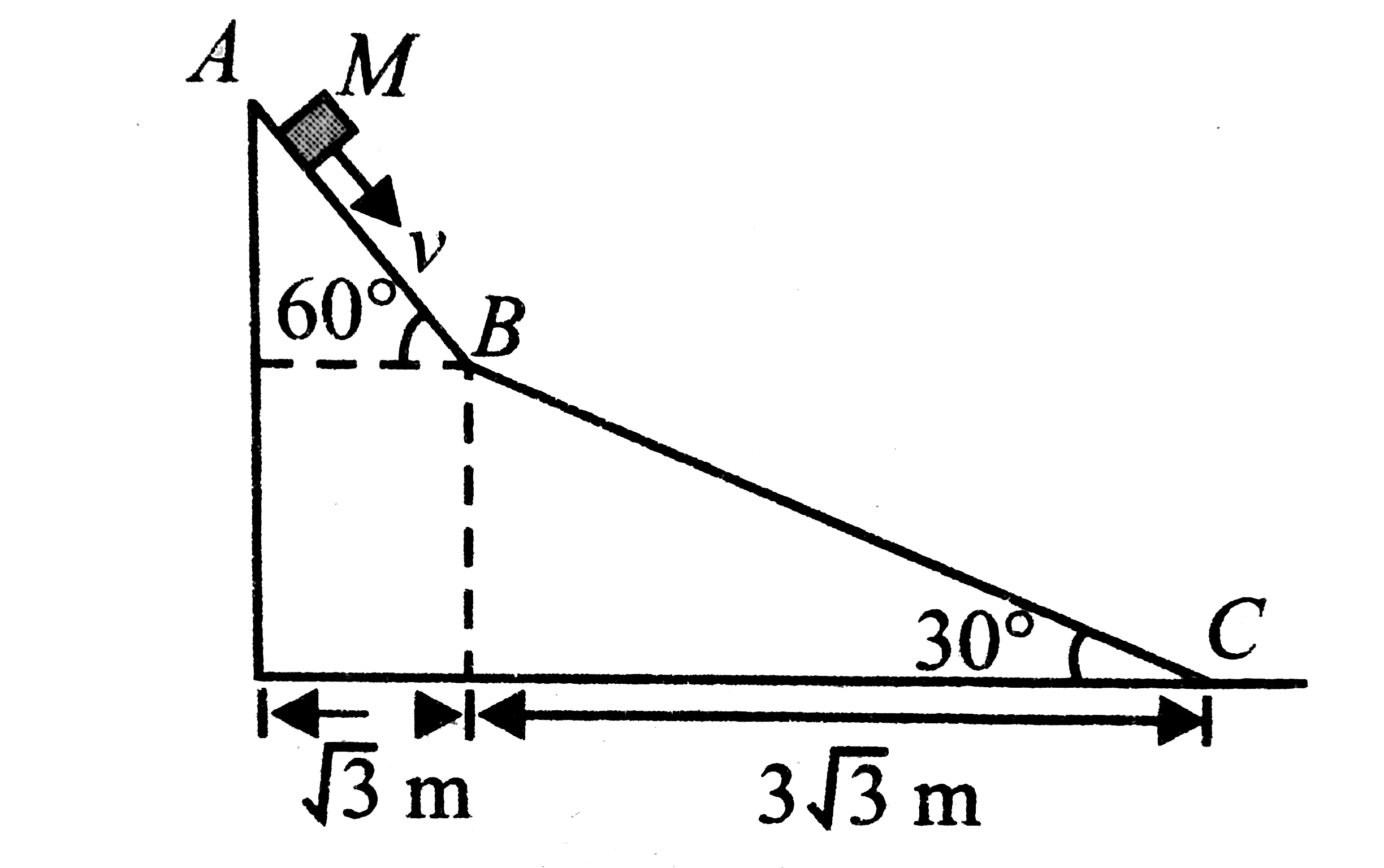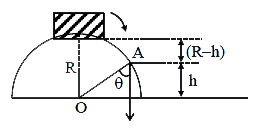A small block of mass M move on a frictionless surface of an inclimed from as down is figure . The engle of the inclime suddenly change from 60∘ to 30∘ at point B . The block is initally at rest at A Assume the collsion between the block and the incline are totally inclassic (g=10m/s2)

The speed of the block at point C immediately before is leaves the second incline is
√120m/s
√105m/s
√30m/s
√75m/s
The correct Answer is:B
v2c=v2B+2g(h2−h1
⇒=vc=√452+2×10×3=√105ms−1
Topper's Solved these Questions
- CENTRE OF MASSBook:ALLENChapter:CENTRE OF MASSExercise:EXERCISE-V A
Explore 20 Videos
- BASIC MATHEMATICS USED IN PHYSICS &VECTORS Book:ALLENChapter:BASIC MATHEMATICS USED IN PHYSICS &VECTORS Exercise:EXERCISE-IV ASSERTION & REASON
Explore 11 Videos
- ELASTICITY, SURFACE TENSION AND FLUID MECHANICSBook:ALLENChapter:ELASTICITY, SURFACE TENSION AND FLUID MECHANICSExercise:Exercise 5 B (Integer Type Questions)
Explore 3 Videos
Similar Questions
Read the given passage and answer the following questions.
A small block of mass M = 1 kg moves on a frictionless surface of an inclined plane, as shown in the figure. The angle of the incline suddenly changes from 60∘ to 30∘ at point Q. The block is initially at rest at point P. Assume that there is no loss of energy for collisions between the block and the incline. (Take g = 10 m s−2)

The speed of the block at point Q immediately before it strikes the second incline is
View SolutionA block of mass 2kg is released from rest on a rough inclined ground as shown in figure. Find the work done on the block by.
 .
.
(Take g10m/s2).
View Solution
Knowledge Check
A small block of mass M move on a frictionless surface of an inclimed from as down is figure . The engle of the inclime suddenly change from 60∘ to 30∘ at point B . The block is initally at rest at A Assume the collsion between the block and the incline are totally inclassic (g=10m/s2)

The speed of the block at point B immedutaly after it strikes the second inclime is - A√60m/sB√45m/sC√30m/sD√15m/s
A√60m/sB√45m/sC√30m/sD√15m/sA small block of mass M move on a frictionless surface of an inclimed from as down is figure . The engle of the inclime suddenly change from 60∘ to 30∘ at point B . The block is initally at rest at A Assume the collsion between the block and the incline are totally inclassic (g=10m/s2)

If collision between the block and the incline is completely elestic , then the vartical (apward) component of the of the block at point B immediatly after it stricess the scond indine is -A√30m/sB√15m/sC0D−√15m/sA small block of mass M moves on a frictionless surface of an inclined plane, as shown in the figure. The angle of the incline suddenly changes from 60∘ to 30∘ at point B. The block is many at rest at A. Assume that collisions between the block id the incline are totally inelastic.
The speed of the block at point C, immediately before it leaves the second incline
 A√120m/sB√105m/sC√90m/sD√75m/s
A√120m/sB√105m/sC√90m/sD√75m/s
A small block slides down from the top of hemisphere of radius R = 3 m as shown in the figure. The height 'h' at which the block will lose contact with the surface of the sphere is __________ m.
(Assume there is no friction between the block and the hemisphere)

View SolutionA block of mass m moves on a horizontal rough surface with initial velocity v. The height of the centre of mass of the block is h from the surface. Consider a point A on the surface.
View SolutionA block kept on a rough inclined plane ,as shown in the figure, remains at rest upto a maximum force 2N down the inclined plane. The maximum external force up the inclined plane that does not move the block is 10N.The coefficient of static friction between the block and the palbe is : [Taking g=10m/s2].

View SolutionA block kept on a rough inclined plane ,as shown in the figure, remains at rest upto a maximum force 2N down the inclined plane. The maximum external force up the inclined plane that does not move the block is 10N.The coefficient of static friction between the block and the palbe is : [Taking g=10m/s2].

View SolutionOn a frictionless surface, a block of mass M moving at speed v collides elastically with another block of same mass M which is initially at rest. After collision the first block moves at an angle θ to its initial direction and has a speed v3. The second block.s speed after the collision is
View Solution

